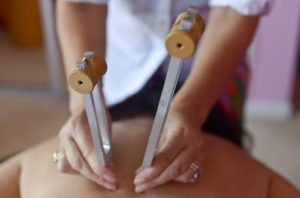Pain Free Treatment
Massage vs Physical Therapy
When a client came to me to help her regain her range of motion in her shoulder after surgery, I knew I could help her. She told me a story of fear and pain at the physical therapists office. The physical therapist was trained to force the range of motion no matter how much it hurt. The therapist would not stop putting pressure on the joint no matter how much she pleaded for individual to stop. She went back to her doctor and begged him to stop the physical therapy. Her doctor noticed that she was visibly anxious and her progress report from the physical therapist showed little to no progress. The doctor told her that she did not have to go back to physical therapy for the time being. She told him that she would rather try an alternative method like massage. He agreed and set up a future re-check appointment for her.
She came to me for massage. I told her that I used weighted tuning forks during my massage and that I had amazing results releasing my other clients muscle tightness. The first time I had her face down on the massage table I was shocked to see that her shoulder was off the table and scrunched up toward her neck. She had her arm in a sling for so long that the muscles were almost frozen in that position. I know that I had my work cut out for me. She stated that her biggest issue was that she had to have someone else tie her hair back in a pony tail. She stated that she was in so much pain she could not lift her arm high enough to perform this simple task.
I worked her neck, shoulders and upper body anterior and posterior. Her muscles started releasing right away but I knew it would take more than one session to get her back to normal. I spent several hours on her that day but by the time I was done her shoulder was laying flatter on the table and she could tie her pony tail without pain. The next visit she told me that she took a bike ride with her young son as soon as she got home after that first treatment. She was ecstatic and relieved. She saw her doctor several weeks later and her doctor immediately noticed how relaxed she was and of course she said to him, “Look what I can do!” She told him about her massage and tuning fork experience and how it actually felt good during treatment. I saw her three times and she resumed her normal routine after that with little to no pain.
Now don’t get me wrong, Physical Therapy is a must have in certain instances but the Therapist should always communicate with the client. If a person is screaming in agony, it is the responsibility of the therapist to adjust treatment so the client has a positive result. There are additional tools that the therapist could use to make that stretch or push less painful. If the therapist does not stop when the client is in agony, the client won’t come back for more treatment.
My desire is to teach physical therapists about the tuning forks and how to use them with their process. The forks are amazing and assist in releasing muscle tension and adhesions around an injury site. The tuning forks also promote healing in the body. It would be much more enjoyable for the client and physical therapy sessions could be cut in half.
Maybe I’ll teach a class to a group of physical therapists some day!








It’s a pity you don’t have a donate button! I’d without a doubt donate to this fantastic blog!
I suppose for now i’ll settle for book-marking and adding your RSS feed to my Google account.
I look forward to fresh updates and will talk about
this site with my Facebook group. Talk soon!
An integrated approach is always important in treatment. The combination of different procedures for the patient should bring a reduction in pain and a complete recovery.